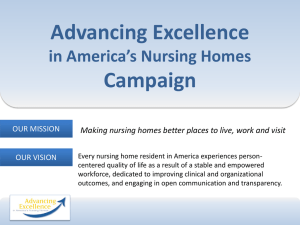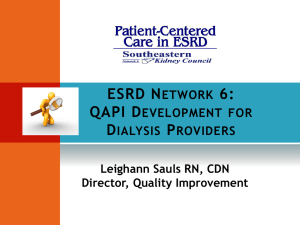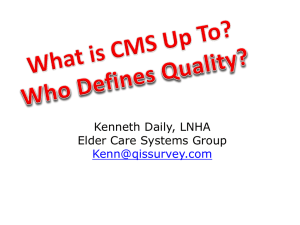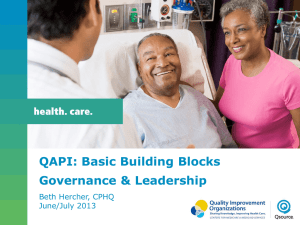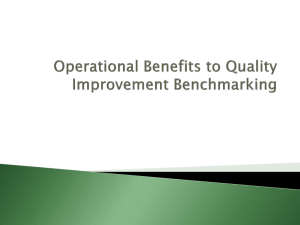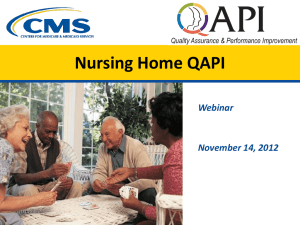ppt - WHA Quality Center
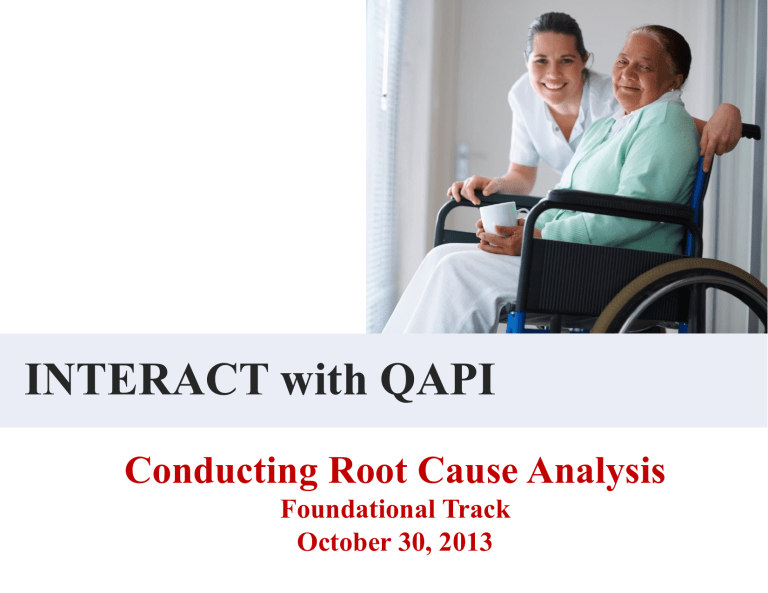
INTERACT with QAPI
Conducting Root Cause Analysis
Foundational Track
October 30, 2013
Educational Credits for Today’s
Webinar
CPHQs – NAHQ approved
Nursing Home Administrators -
NAB-NCERS approved
Nurses – approved nsg. contact hours
Physicians – AMA PRA Category 1 Credit TM
PTs – WPTA approved
Social Workers – NASW approved
Dietitian – pending from CDR
Attendance Verification for
Credits
Full SERIES attendance (four webinars) and
Evaluation: Copy and enter into your web browser: http://www.surveymonkey.com/s/Interact10-30-
13
Social Workers – post-test required (is part of eval)
Everyone please complete the online evaluation – thank you!
Disclosures
No commercial support for webinar
Speaker or planner conflicts of interest –
None
Learning Objectives
Following this webinar, you will be able to:
Identify best practices for the RCA process
Use the Acute Care Transfer Log Tool to determine causative factors that relate to unnecessary readmissions
Use the Quality Improvement Tool for Review of
Acute Care Transfers
Use the Quality Improvement Summary Worksheet
Today’s Presenters
Jody Rothe, RN, WCC
Stephanie Sobczak, MS, MBA
Connie Gliniecki, RN, DON
INTERACT with QAPI
Root Cause Analysis Webinar
Notes for Logging into INTERACT with QAPI Webinar Series:
Please dial into the 1-800 phone line separately from your computer’s webinar login steps.
Please MUTE your computer speakers during the webinar.
Never place your phone on HOLD during the webinar.
Unless you are speaking, please MUTE the phone line by selecting *6.
You can un-MUTE your phone line to speak by selecting *7.
Keep intentional background noise to a minimum during the webinar.
By following these instructions, a better webinar experience will be possible for all participants.
Thank you.
7 INTERACT with QAPI
Collaborating Organizations
And our Expert Advisory Panel:
• Barb Beardsley - DON, Brookside Care Center
• Connie Gliniecki - DON, Kennedy Park Nursing and Rehab Center
• Lisa Gervais - NHA, Pine Crest Nursing Home
• Kristen Strother - MSW, Manager of Social Work, Case Management and Abuse Response Services, Aurora Sinai Medical Center
INTERACT with QAPI 8
Today’s Agenda
1. Sharing from Connie
2. Best Practice Processes for Conducting a
Root Cause Analysis (RCA)
3. AE Safely Reduce Hospitalization Tool
4. The QI Tool for Review of Transfers
5. QI Summary Worksheet
6. Suggested Action Steps
INTERACT with QAPI 9
INTERACT with QAPI 10
From the Expert
Connie Gliniecki - DON, Kennedy Park Nursing and Rehab Center
• The importance of doing an RCA
• What works well and what doesn’t
• Learning from the process
• Part of QAPI
• Should be completed by any staff at the time of an identified problem
11
INTERACT with QAPI
From the Beginning…
Do you have a consistent process for conducting RCAs?
Are the same people leading or instructing others in the RCA?
How are the caregivers involved with the patient included in the RCA?
INTERACT with QAPI
12
Best Practices for RCA
1. Involve those who worked with the resident– interview them
2. Follow the Tool and assess all the questions
3. Meet to compare findings and determine what the cases have in common
4. If there is not a clear root cause, use the 5
Why Approach
13 INTERACT with QAPI
Best Practices for RCA
1. Involve those who worked with the patient – interview them
2. Follow the Tool and assess all the questions
3. Meet to compare findings and determine what the cases have in common
4. If there is not a clear root cause, use the 5
Why Approach
14 INTERACT with QAPI
Best Practices for RCA
1. Involve those who worked with the patient
– interview them
2. Follow the Tool and assess all the questions
3. Meet to compare findings and determine what the cases have in common
4. If there is not clear root cause, use the 5
Why Approach
15 INTERACT with QAPI
INTERACT QI Tool
INTERACT with QAPI
16
INTERACT QI Tool
Which of these are most common?
Helps you determine which processes might be improved or refined.
INTERACT with QAPI
17
INTERACT QI Tool Example
INTERACT with QAPI
18
Introducing the Tool to Staff
First have at least one experienced staff person review tool and try RCA with one case.
To continue;
• Option 1- Introduce the RCA with one staff person at a time and ask them to fill out the
QI tool
• Option 2- Introduce the RCA to the team and ask them to Interview people involved with a recent readmission
19
INTERACT with QAPI
Best Practices for RCA
1. Involve those who worked with the patient
– interview them
2. Follow the Tool and assess all the questions
3. Meet to compare findings and determine what the cases have in common
4. If there is not clear root cause, use the 5
Why Approach
20 INTERACT with QAPI
INTERACT QI Summary Worksheet
21
INTERACT with QAPI
INTERACT QI Summary Worksheet
22
INTERACT with QAPI
Best Practices for RCA
1. Involve those who worked with the patient
– interview them
2. Follow the Tool and assess all the questions
3. Meet to compare findings and determine what the cases have in common
4. If there is no clear root cause, use the 5
Why Approach
23 INTERACT with QAPI
The 5 Why Approach
Case Example:
Two patients were sent to the hospital in the past 2 weeks because of decreased fluid intake or very low urinary output. In both cases the physician determined patients were dehydrated, and after giving fluids, each was able to return to the facility.
24 INTERACT with QAPI
The 5 Why Approach
Mrs. Adams’ dehydration:
She was refusing to drink water
Why?
She will only drink bottled water
Why?
Her daughters tell her bottled water is better for her and bring her a supply of bottled water.
She was out of bottled water, so we need to supply bottled water.
25 INTERACT with QAPI
The 5 Why Approach
Mr. Brown’s dehydration:
No history of swallowing difficulties but was dehydrated
Why?
Patient had mentioned a sore throat
Why?
Patient had an endoscopy 3 days ago and hasn’t been drinking water at bedside or meals.
Throat pain caused by procedure that staff were not aware of; were unaware of degree of discomfort for the patient.
26 INTERACT with QAPI
The 5 Why Approach
Mr. Brown’s dehydration:
Throat pain caused by procedure that staff were not aware of; were unaware of degree of discomfort for the patient.
Why was staff unaware of the procedure?
The physician’s note and follow-up instructions were not received.
Why?
No standard process with clinics for information/follow-up after appointments.
27 INTERACT with QAPI
Commonly Discovered
Root Causes
Communication breakdowns:
• Missed signs of resident condition changes
• Staff respond to clinical situations differently
• Handoff problems with other organizations
• INTERACT Tools not consistently used
28
INTERACT with QAPI
Prioritizing Findings
• Come to a group consensus on the top 2 or 3 things that could be improved based on your
Root Cause Analysis
• Update your QAPI Goal Setting Worksheet
29
INTERACT with QAPI
QAPI
• Use QAPI Toolkit for your performance improvement plan
• Revisit your Goal Setting Worksheet to update your plan based on your finding from the Root Cause Analysis
30
INTERACT with QAPI
How INTERACT Links to Root Causes
Communication breakdowns
SBAR
Missed signs of resident condition changes
Stop and Watch Tool
Staff respond to clinical situations differently
Care Pathways
Handoff problems with other organizations
Transfer Tools
INTERACT with QAPI
31
Make a Plan to Do the Improvements
What?
What will you do for action steps?
Who?
Who will do the work? Who should be involved?
When?
When should steps be completed by?
How?
How will you make progress?
How will you know progress is on track?
INTERACT with QAPI
32
“How is it Going” Checklist
Are you meeting as a team?
Is data being gathered and submitted in a timely way?
Have you agreed upon clear next steps
Have you connected with other staff to participate in the effort?
Are you updating your QAPI Goals
Worksheet?
INTERACT with QAPI
33
Recommended Action Items
Root Cause Analysis Action Items
1. Determine who is involved in tracking transfers; check on data submission
2. Review 3-5 Acute Care Transfers with the team; use QI Tool and determine root causes
3. Modify your QAPI Goal Setting
Worksheet (your PIP) and develop a plan
4. Submit data
INTERACT with QAPI 34
Online Resources
Recorded Webinars available on:
Wisconsin Clinical Resource Center https://wcrc.chsra.wisc.edu
WHA Quality Center
(Requires your WCRC Username and Password) http://www.whaqualitycenter.org/LearningOpportunities/INTERACTwithQAPI.aspx
Other resources:
INTERACT Website http://interact2.net/
MetaStar QAPI Resources http://www.metastar.com/web/Default.aspx?tabid=573
Advancing Excellence – Safely Reduce Hospitalizations Tracking Tool (Data spreadsheet) http://www.nhqualitycampaign.org/star_index.aspx?controls=hospitalizationsidentifybaseline
35 INTERACT with QAPI
References
INTERACT with QAPI 36
Attendance Verification for
Credits
Full SERIES attendance (four webinars) and
Evaluation: Copy and enter into your web browser: http://www.surveymonkey.com/s/Interact10-30-
13
Social Workers – post-test required (is part of eval)
Everyone please complete the online evaluation – thank you!
Contact Information:
Jody Rothe, RN, WCC
Quality Consultant
MetaStar, Inc.
2909 Landmark Place
Madison, WI 53713
Phone number: (608) 441-8271 or (800) 362-2320 www.metastar.com
jrothe@metastar.com
INTERACT with QAPI 38
